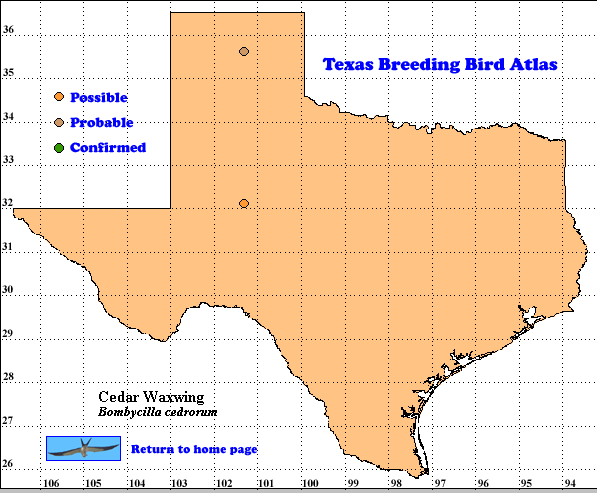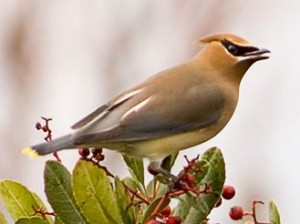A sleek, crested bird with silky brown plumage, black mask, and yellowish flanks, the
Cedar Waxwing has a yellow-tipped tail and often sports a red wax-like spot on its wings, hence its name. This waxwing is found throughout North America, in the northern half year-round and during winter in the southern half.
DISTRIBUTION: Oberholser (1974) shows summer sightings in 7 counties, all downstate from the Panhandle, while the TBBA revealed almost the opposite: one sighting on the Southern Plains and one in the Panhandle.
SEASONAL OCCURRENCE: In Texas, the Cedar Waxwing is a common to abundant winter resident in all parts of the state except the Trans-Pecos, where it is irregular and uncommon (Lockwood and Freeman 2004). Oberholser (1974) gives wintering dates of mid-October to late May, with few exceptions. In the Panhandle the dates range from late August to early June (Seyffert 2001).
BREEDING HABITAT: A species whose breeding cycle coincides with the seasonal availability of summer-ripening fruits, the Cedar Waxwing nests in deciduous, coniferous, and mixed woodlands, as well as farms, orchards, and suburban gardens. In arid areas breeding is usually associated with water (Witmer et al.. 1997).
STATUS: Other than a single possible — June 18 and July 12 (latilong 32101-B4) — the sole quad classified probable was in latilong 35101-F4. The latter observation involved a flightless juvenile accompanied by adults found October 19 in a suburban backyard in Borger. A probable classification was thought appropriate rather than a confirmed as it was not known with certainty that the young bird was hatched locally. This was not the first Panhandle record of a Cedar Waxwing observed in streaked juvenal feather as several previous sightings had been made during August and September. On one occasion as many as five young birds in a single group August 17 provided further evidence of possible nesting in the area (Seyffert 1991).
The possibility, if not probability, that the Cedar Waxwing nests occasionally in northwest Texas is reinforced by nestings confirmed in nearby areas of the Oklahoma Panhandle (Sutton 1967). Confirmed and probable nestings have also been recorded in recent years in northern New Mexico (Williams 1995). An October nesting date may be questioned, however the Cedar Waxwing is among the latest nesting birds in North America with nest initiation occurring as late as late September and early October, and the species is known to be two-brooded (Witmer et a!. 1997). Text by Kenneth D. Seyffert (Posted with updates 2006)
 Literature cited.
Literature cited.
Lockwood, M. W. and B. Freeman. 2004. The TOS handbook of Texas birds. Texas A&M University Press, College Station.
Oberholser, H. C. 1974. The bird life of Texas. University of Texas Press, Austin.
Seyffert, K. D. 1991. Does the Cedar Waxwing nest in the Texas Panhandle. Bull. Texas Ornithol. Soc. 24: 54-56.
Seyffert, K. D. 2001. Birds of the Texas Panhandle. Texas A&M University Press, College Station.
Sutton, G. M. 1967. Oklahoma birds. University of Oklahoma Press, Norman.
Williams, S. O., III. 1995. New Mexico. Aud. Field Notes 49: 961-963.
Witmer, M. C., D. J. Mountjoy and L. Elliot. 1997.Cedar Waxwing (Bombycilla cedrorum). In
The Birds of North America, No. 309 (A. Poole and F. Gill, eds.). The birds of North America, Inc., Philadelphia, PA.
